Systematik der Kolibris
Zur Familie der Kolibris (Trochilidae) gehören über 300 Arten. Traditionell wurden die Kolibris in zwei Unterfamilien unterteilt, die Eremiten (Phaethornithinae) und die Eigentlichen Kolibris (Trochilinae)[1]. Neuere phylogenetische Untersuchungen zeigen jedoch, dass die Kolibris aus neun Hauptkladen bestehen, eine davon sind die Phaethornithinae. Zu den übrigen acht Kladen gehören die Topazini, die basal zu allen übrigen Kladen stehen, also die Schwestergruppe aller übrigen Kolibris sind. Die Trochilinae sind deshalb keine monophyletische Gruppe, beinhalten also nicht alle Nachfahren des letzten gemeinsamen Vorfahren, und können in einer modernen Systematik deshalb nicht mehr verwendet werden.[2] In der folgenden Systematik der Kolibris wurden die Gattungen und Arten nach den neun Hauptkladen geordnet.
| Kladogramm der Kolibris nach McGuire et al. (2007 u. 2008) | |||||||||||||||||||||||||||||||||||||||||||||||||||
|---|---|---|---|---|---|---|---|---|---|---|---|---|---|---|---|---|---|---|---|---|---|---|---|---|---|---|---|---|---|---|---|---|---|---|---|---|---|---|---|---|---|---|---|---|---|---|---|---|---|---|---|
| |||||||||||||||||||||||||||||||||||||||||||||||||||
- Topazini (Topazes)
- Gattung Florisuga
.jpg.webp) Schwarzkolibri (Florisuga fusca)
Schwarzkolibri (Florisuga fusca)- Schwarzkolibri (Florisuga fusca)
- Weißnackenkolibri (Florisuga mellivora)
- Gattung Topaza
- Flammenkolibri (Topaza pyra)
- Rotnacken-Topaskolibri (Topaza pella)
- Gattung Florisuga
- Phaethornithinae (Eremiten)
- Gattung Anopetia
- Caatingaschattenkolibri (Anopetia gounellei)
- Gattung Adlerschnabelkolibris (Eutoxeres)
- Rotschwanz-Adlerschnabel (Eutoxeres condamini)
- Adlerschnabel (Eutoxeres aquila)
- Gattung Glaucis
- Kupferschattenkolibri (Glaucis aeneus)
- Bronzeschwanz-Schattenkolibri (Glaucis dohrnii)
- Rotschwanz-Schattenkolibri (Glaucis hirsutus)
- Gattung Phaethornis
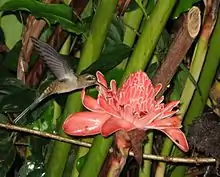 Westlicher Langschwanz-Schattenkolibri (Phaethornis longirostris)
Westlicher Langschwanz-Schattenkolibri (Phaethornis longirostris)- Tapajosschattenkolibri (Phaethornis aethopygus)
- Fleckenkehl-Schattenkolibri (Phaethornis anthophilus)
- Schwarzkehl-Schattenkolibri (Phaethornis atrimentalis)
- Graubauch-Schattenkolibri (Phaethornis augusti)
- Braunbauch-Schattenkolibri (Phaethornis bourcieri)
- Schuppenkehl-Schattenkolibri (Phaethornis eurynome)
- Binden-Zwergschattenkolibri (Phaethornis griseogularis)
- Grüner Schattenkolibri (Phaethornis guy)
- Weißbart-Schattenkolibri (Phaethornis hispidus)
- Schiller-Zwergschattenkolibri (Phaethornis idaliae)
- Orangebrauner Schattenkolibri (Phaethornis koepckeae)
- Westlicher Langschwanz-Schattenkolibri (Phaethornis longirostris)
- Brauner Zwergschattenkolibri (Phaethornis longuemareus)
- Dunkler Schattenkolibri (Phaethornis malaris)
- Mexikoschattenkolibri (Phaethornis mexicanus)
- Zimtkehl-Schattenkolibri (Phaethornis nattereri)
- Orangefarbener Schattenkolibri (Phaethornis philippii)
- Zimtroter Schattenkolibri (Phaethornis pretrei)
- Roter Zwergschattenkolibri (Phaethornis ruber)
- Strichelkehl-Schattenkolibri (Phaethornis rupurumii)
- Ockerbauch-Schattenkolibri (Phaethornis subochraceus)
- Östlicher Langschwanz-Schattenkolibri (Phaethornis superciliosus)
- Dunkelkehl-Schattenkolibri (Phaethornis squalidus)
- Streifenkehl-Schattenkolibri (Phaethornis striigularis)
- Stuarts Zwergschattenkolibri (Phaethornis stuarti)
- Orangebauch-Schattenkolibri (Phaethornis syrmatophorus)
- Smaragdschattenkolibri (Phaethornis yaruqui)
- Gattung Ramphodon
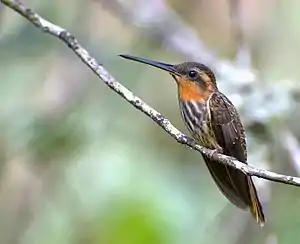 Sägeschnabel-Schattenkolibri (Ramphodon naevius)
Sägeschnabel-Schattenkolibri (Ramphodon naevius)- Sägeschnabel-Schattenkolibri (Ramphodon naevius)
- Gattung Threnetes
- Orangekehl-Schattenkolibri (Threnetes leucurus)
- Rußschattenkolibri (Threnetes niger)
- Weißbinden-Schattenkolibri (Threnetes ruckeri)
- Gattung Anopetia
- Polytmini (Mangoes)
- Gattung Androdon
- Zahnschnabelkolibri (Androdon aequatorialis)
- Gattung Anthracothorax
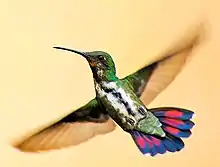 Schwarzbrust-Mangokolibri (Anthracothorax nigricollis)
Schwarzbrust-Mangokolibri (Anthracothorax nigricollis)- Dominikanermangokolibri (Anthracothorax dominicus)
- Jamaikamangokolibri (Anthracothorax mango)
- Schwarzbrust-Mangokolibri (Anthracothorax nigricollis)
- Grünbrust-Mangokolibri (Anthracothorax prevostii)
- Veragua-Mangokolibri (Anthracothorax veraguensis)
- Smaragdkehl-Mangokolibri (Anthracothorax viridigula)
- Smaragdmangokolibri (Anthracothorax viridis)
- Gattung Augastes
- Goldmaskenkolibri (Augastes lumachella)
- Grünmaskenkolibri (Augastes scutatus)
- Gattung Avocettula
- Schwarzbauch-Avosettkolibri (Avocettula recurvirostris)
- Gattung Chrysolampis
- Moskitokolibri (Chrysolampis mosquitus)
- Gattung Colibri
- Berg-Veilchenohrkolibri (Colibri cyanotus)[3]
- Brauner Veilchenohrkolibri (Colibri delphinae)
- Kleiner Veilchenohrkolibri (Colibri thalassinus)
- Großer Veilchenohrkolibri (Colibri coruscans)
- Amethystohrkolibri (Colibri serrirostris)
- Gattung Doryfera
- Blaustirn-Lanzettschnabel (Doryfera johannae)
- Grünstirn-Lanzettschnabel (Doryfera ludovicae)
- Gattung Eulampis
.JPG.webp) Blaustern-Antillenkolibri (Eulampis holosericeus holosericeus) auf Barbados
Blaustern-Antillenkolibri (Eulampis holosericeus holosericeus) auf Barbados- Blaustern-Antillenkolibri (Eulampis holosericeus)
- Purpurkehlkolibri (Eulampis jugularis)
- Gattung Heliactin
- Goldhauben-Schmuckkolibri (Heliactin bilophus)
- Gattung Heliothryx
- Schwarzohr-Schmuckkolibri (Heliothryx auritus)
- Purpurkron-Schmuckkolibri (Heliothryx barroti)
- Gattung Polytmus
- Bronzerücken-Glanzkehlchen (Polytmus guainumbi)
- Tepuiglanzkehlchen (Polytmus milleri)
- Grünschwanz-Glanzkehlchen (Polytmus theresiae)
- Gattung Schistes
- Bunthalskolibri (Schistes geoffroyi).
- Gattung Androdon
- Lophornitini (Coquettes)
- Gattung Adelomyia
- Schwarzohrkolibri (Adelomyia melanogenys),
- Gattung Aglaiocercus
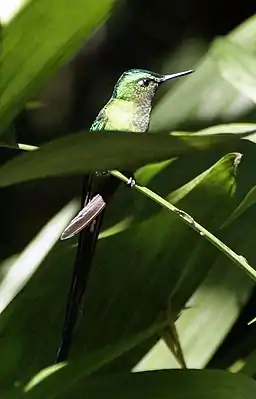 Himmelssylphe (Aglaiocercus kingii) ♂
Himmelssylphe (Aglaiocercus kingii) ♂- Berlepschsylphe (Aglaiocercus berlepschi)
- Langschwanzsylphe (Aglaiocercus coelestis)
- Himmelssylphe (Aglaiocercus kingii)
- Gattung Chalcostigma
- Weißspitzen-Glanzschwänzchen (Chalcostigma herrani)
- Bronzeglanzschwänzchen (Chalcostigma heteropogon)
- Braunes Glanzschwänzchen (Chalcostigma olivaceum)
- Kastanienkappen-Glanzschwänzchen (Chalcostigma ruficeps)
- Schwarzkopf-Glanzschwänzchen (Chalcostigma stanleyi)
- Gattung Discosura
- Grüne Fadenelfe (Discosura conversii)
- Brustband-Fadenelfe (Discosura langsdorffi)
- Kupferfadenelfe (Discosura letitiae)
- Diskuselfe (Discosura longicaudus)
- Haubenfadenelfe (Discosura popelairii)
- Gattung Heliangelus
_-NBII_Image_Gallery-a00194.jpg.webp) Amethystsonnennymphe (Heliangelus amethysticollis)
Amethystsonnennymphe (Heliangelus amethysticollis)- Amethystsonnennymphe (Heliangelus amethysticollis)
- Grünband-Sonnennymphe (Heliangelus exortis)
- Orangekehl-Sonnennymphe (Heliangelus mavors)
- Goldkehl-Sonnennymphe (Heliangelus micraster)
- Blaue Sonnennymphe (Heliangelus regalis)
- Weißband-Sonnennymphe (Heliangelus strophianus)
- Purpurkehl-Sonnennymphe (Heliangelus viola)
- Smaragdkehl-Sonnennymphe (Heliangelus zusii)
- Gattung Lesbia
.jpg.webp) Schwarzschwanzsylphe (Lesbia victoriae)
Schwarzschwanzsylphe (Lesbia victoriae)- Grünschwanzsylphe (Lesbia nuna)
- Schwarzschwanzsylphe (Lesbia victoriae)
- Gattung Lophornis
.jpg.webp) Zierelfe (Lophornis delattrei)
Zierelfe (Lophornis delattrei)- Weißschopfelfe (Lophornis adorabilis)
- Kurzhaubenelfe (Lophornis brachylophus)
- Schmetterlingselfe (Lophornis chalybeus)
- Grünschopfelfe (Lophornis verreauxii)
- Zierelfe (Lophornis delattrei)
- Gouldelfe (Lophornis gouldii)
- Schwarzschopfelfe (Lophornis helenae)
- Prachtelfe (Lophornis magnificus)
- Schmuckelfe (Lophornis ornatus)
- Pfauenelfe (Lophornis pavoninus)
- Glanzelfe (Lophornis stictolophus)
- Gattung Metallura
- Schuppenbauch-Glanzschwänzchen (Metallura aeneocauda)
- Violettkehl-Glanzschwänzchen (Metallura baroni)
- Feuerkehl-Glanzschwänzchen (Metallura eupogon)
- Rotschwanz-Glanzschwänzchen (Metallura iracunda)
- Purpurkehl-Glanzschwänzchen (Metallura odomae)
- Schwarzbauch-Glanzschwänzchen (Metallura phoebe)
- Kupferglanzschwänzchen (Metallura theresiae)
- Smaragdkehl-Glanzschwänzchen (Metallura tyrianthina)
- Grünes Glanzschwänzchen (Metallura williami)
- Gattung Opisthoprora
- Fleckenbauch-Avosettkolibri (Opisthoprora euryptera)
- Gattung Oreonympha
- Weißhalssylphe (Oreonympha nobilis)
- Gattung Oreotrochilus
- Rotflanken-Andenkolibri (Oreotrochilus adela)
- Ecuador-Andenkolibri (Oreotrochilus chimborazo)
- Blaulatzkolibri Oreotrochilus cyanolaemus
- Estella-Andenkolibri (Oreotrochilus estella)
- Weißflanken-Andenkolibri (Oreotrochilus leucopleurus)
- Schwarzbrust-Andenkolibri (Oreotrochilus melanogaster)
- Grünkopf-Andenkolibri (Oreotrochilus stolzmanni)
- Gattung Oxypogon
- Blaubart-Helmkolibri (Oxypogon cyanolaemus)
- Grünbart-Helmkolibri (Oxypogon guerinii)
- Gattung Phlogophilus
- Hartertkolibri (Phlogophilus harterti)
- Schwarzweißschwanz-Kolibri (Phlogophilus hemileucurus)
- Gattung Polyonymus
- Rosenkehlsylphe (Polyonymus caroli)
- Gattung Ramphomicron
- Schwarzer Kurzschnabelkolibri (Ramphomicron dorsale)
- Purpur-Kurzschnabelkolibri (Ramphomicron microrhynchum)
- Gattung Sappho
- Goldschwanzsylphe (Sappho sparganurus)
- Gattung Sephanoides
- Juan-Fernandez-Kolibri (Sephanoides fernandensis)
- Chilekolibri (Sephanoides sephanoides)
- Gattung Taphrolesbia
- Graubauchsylphe (Taphrolesbia griseiventris)
- Gattung Adelomyia
- Coeligini (Brilliants)
- Gattung Aglaeactis
- Maronenkolibri (Aglaeactis aliciae)
- Rotbrust-Andenkolibri (Aglaeactis castelnaudii)
- Rostroter Andenkolibri (Aglaeactis cupripennis)
- Schwarzbauch-Andenkolibri (Aglaeactis pamela)
- Gattung Boissonneaua
 Fahlschwanzkolibri (Boissonneaua flavescens)
Fahlschwanzkolibri (Boissonneaua flavescens)- Fahlschwanzkolibri (Boissonneaua flavescens)
- Hyazinthkolibri (Boissonneaua jardini)
- Rotbauchkolibri (Boissonneaua matthewsii)
- Gattung Clytolaema
- Rubinkolibri (Clytolaema rubricauda)
- Gattung Coeligena
 Bronzeandenkolibri (Coeligena coeligena)
Bronzeandenkolibri (Coeligena coeligena)- Goldbauch-Andenkolibri (Coeligena bonapartei)
- Bronzeandenkolibri (Coeligena coeligena)
- Rosenbauch-Andenkolibri (Coeligena helianthea)
- Grünroter Andenkolibri (Coeligena iris)
- Fahlflügel-Andenkolibri (Coeligena lutetiae)
- Antioquia-Andenkolibri (Coeligena orina)
- Weißschwanz-Andenkolibri (Coeligena phalerata)
- Blauschulter-Andenkolibri (Coeligena prunellei)
- Brustband-Andenkolibri (Coeligena torquata)
- Veilchenkehl-Andenkolibri (Coeligena violifer)
- Brauner Andenkolibri (Coeligena wilsoni)
- Gattung Ensifera
- Schwertschnabelkolibri (Ensifera ensifera)
- Gattung Eriocnemis
.jpg.webp) Langschwanz-Höschenkolibri (Eriocnemis luciani)
Langschwanz-Höschenkolibri (Eriocnemis luciani)- Weißbrust-Höschenkolibri (Eriocnemis aline)
- Kupferbauch-Höschenkolibri (Eriocnemis cupreoventris)
- Schwarzfeder-Höschenkolibri (Eriocnemis derbyi)
- Blaustirn-Höschenkolibri (Eriocnemis glaucopoides)
- Türkiskehl-Höschenkolibri (Eriocnemis godini)
- Isabella-Schneehöschen (Eriocnemis isabellae)
- Langschwanz-Höschenkolibri (Eriocnemis luciani)
- Blaubauch-Höschenkolibri (Eriocnemis mirabilis)
- Goldbrust-Höschenkolibri (Eriocnemis mosquera)
- Schwarzbauch-Höschenkolibri (Eriocnemis nigrivestis)
- Violettkehl-Höschenkolibri (Eriocnemis vestita)
- Gattung Haplophaedia
- Fahlschenkel-Höschenkolibri (Haplophaedia assimilis)
- Kupferglanz-Höschenkolibri (Haplophaedia aureliae)
- Schuppenbauch-Höschenkolibri (Haplophaedia lugens)
- Gattung Heliodoxa
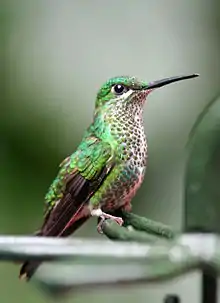 Grünstirn-Brillantkolibri (Heliodoxa jacula)
Grünstirn-Brillantkolibri (Heliodoxa jacula)- Rotbrust-Brillantkolibri (Heliodoxa aurescens)
- Rotflügel-Brillantkolibri (Heliodoxa branickii)
- Rotkehl-Brillantkolibri (Heliodoxa gularis)
- Rotstern-Brillantkolibri (Heliodoxa imperatrix)
- Grünstirn-Brillantkolibri (Heliodoxa jacula)
- Violettstirn-Brillantkolibri (Heliodoxa leadbeateri)
- Braunbauch-Brillantkolibri (Heliodoxa rubinoides)
- Schwarzkehl-Brillantkolibri (Heliodoxa schreibersii)
- Grüner Brillantkolibri (Heliodoxa xanthogonys)
- Gattung Lafresnaya
- Samtbauchkolibri (Lafresnaya lafresnayi)
- Gattung Loddigesia
- Violettscheitel-Flaggensylphe (Loddigesia mirabilis)
- Gattung Ocreatus
- Grünscheitel-Flaggensylphe (Ocreatus underwoodii)
- Gattung Pterophanes
- Blauflügelkolibri (Pterophanes cyanopterus)
- Gattung Urochroa
- Orangerachen-Andenkolibri (Urochroa bougueri)
- Blaukehl-Andenkolibri (Urochroa leucura)
- Gattung Urosticte
- Purpurbrustkolibri (Urosticte benjamini)
- Rotsteißkolibri (Urosticte ruficrissa)
- Gattung Aglaeactis
- Patagonini
- Gattung Patagona
- Riesenkolibri (Patagona gigas)
- Gattung Patagona
- Lampornithini (Mountain gems)
- Gattung Eugenes
- Violettkron-Brillantkolibri (Eugenes fulgens)
- Gattung Heliomaster
 Funkenkehlkolibri (Heliomaster constantii)
Funkenkehlkolibri (Heliomaster constantii)- Funkenkehlkolibri (Heliomaster constantii)
- Blaubartkolibri (Heliomaster furcifer)
- Rosenkehlkolibri (Heliomaster longirostris)
- Violettkehlkolibri (Heliomaster squamosus)
- Gattung Hylonympha
- Scherenschwanznymphe (Hylonympha macrocerca)
- Gattung Lamprolaima
- Granatkehlkolibri (Lamprolaima rhami)
- Gattung Lampornis
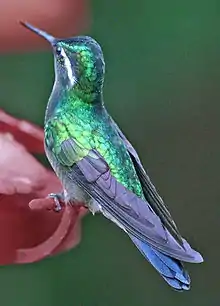 Purpurkehlnymphe (Lampornis calolaemus)
Purpurkehlnymphe (Lampornis calolaemus)- Rotkehlnymphe (Lampornis amethystinus)
- Purpurkehlnymphe (Lampornis calolaemus)
- Weißkehlnymphe (Lampornis castaneoventris)
- Grauschwanznymphe (Lampornis cinereicauda)
- Blaukehlnymphe (Lampornis clemenciae)
- Veilchenkehlnymphe (Lampornis hemileucus)
- Grünbrustnymphe (Lampornis sybillae)
- Grünkehlnymphe (Lampornis viridipallens)
- Gattung Panterpe
- Feuerkehlkolibri (Panterpe insignis)
- Gattung Sternoclyta
- Veilchenbrustkolibri (Sternoclyta cyanopectus)
- Gattung Eugenes
- Mellisugini (Bees)
- Gattung Archilochus
- Schwarzkinnkolibri (Archilochus alexandri)
- Rubinkehlkolibri (Archilochus colubris)
- Gattung Calliphlox
- Amethyststernkolibri (Calliphlox amethystina)
- Violettkehl-Sternkolibri (Calliphlox bryantae)
- Bahamasternkolibri (Calliphlox evelynae)
- Purpurkehl-Sternkolibri (Calliphlox mitchellii)
- Gattung Calypte
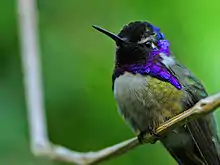 Veilchenkopfelfe (Calypte costae)
Veilchenkopfelfe (Calypte costae)- Annakolibri (Calypte anna)
- Veilchenkopfelfe (Calypte costae)
- Gattung Chaetocercus
- Santa-Marta-Elfe (Chaetocercus astreans)
- Esmeraldaselfe (Chaetocercus berlepschi)
- Hummelelfe (Chaetocercus bombus)
- Prachtkehlelfe (Chaetocercus heliodor)
- Rotfahnenelfe (Chaetocercus jourdanii)
- Weißbauchelfe (Chaetocercus mulsant)
- Gattung Myrtis
- Türkiskehlelfe (Myrtis fanny)
- Gattung Rhodopis
- Atacamakolibri (Rhodopis vesper)
- Gattung Selasphorus
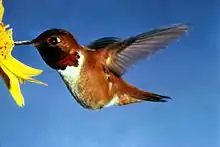 Rotrücken-Zimtelfe (Selasphorus rufus)
Rotrücken-Zimtelfe (Selasphorus rufus)- Feuerkehlelfe (Selasphorus ardens)
- Sternelfe (Selasphorus calliope)
- Vulkanelfe (Selasphorus flammula)
- Breitschwanzelfe (Selasphorus platycercus)
- Rotrücken-Zimtelfe (Selasphorus rufus)
- Grünrücken-Zimtelfe (Selasphorus sasin)
- Orangekehlelfe (Selasphorus scintilla)
- Gattung Atthis
- Elliotelfe (Atthis ellioti)
- Rosenkehlelfe (Atthis heloisa)
- Gattung Calothorax
- Luzifersternkolibri (Calothorax lucifer)
- Schmucksternkolibri (Calothorax pulcher)
- Gattung Doricha
- Rosenkehl-Sternkolibri (Doricha eliza)
- Scherenschwanz-Sternkolibri (Doricha enicura)
- Gattung Eulidia
- Aricaelfe (Eulidia yarrellii)
- Gattung Mellisuga
- Bienenelfe (Mellisuga helenae)
- Zwergelfe (Mellisuga minima)
- Gattung Microstilbon
- Rotbart-Sternkolibri (Microstilbon burmeisteri)
- Gattung Myrmia
- Kurzschwanzelfe (Myrmia micrura)
- Gattung Tilmatura
- Blaukehl-Sternkolibri (Tilmatura dupontii)
- Gattung Thaumastura
- Corakolibri (Thaumastura cora)
- Gattung Archilochus
- Trochilini (Emeralds)
- Gattung Abeillia
- Smaragdkehlkolibri (Abeillia abeillei)
- Gattung Elliotomyia
- Weißbauchamazilie (Elliotomyia chionogaster)
- Grünweißamazilie (Elliotomyia viridicauda)
- Gattung Amazilia
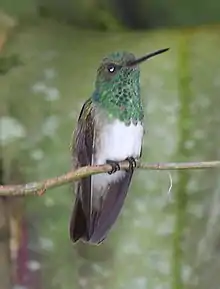 Edwardamazilie (Amazilia edward)
Edwardamazilie (Amazilia edward)
- Gattung Abeillia
- Andenamazilie (Amazilia franciae)
- Beryllamazilie (Saucerottia beryllina)
- Blaubrustamazilie (Polyerata amabilis)
- Blaugrün-Amazilie (Amazilia rondoniae)
- Blaukappenamazilie (Saucerottia cyanifrons)
- Blaukopfamazilie (Saucerottia cyanocephala)
- Blauschwanzamazilie (Saucerottia cyanura)
- Blausteißamazilie (Saucerottia hoffmanni)
- Braunbauchamazilie (Saucerottia castaneiventris)
- Braunschwanzamazilie (Amazilia tzacatl)
- Bronzekopfamazilie (Amazilia candida)
- Edwardamazilie (Saucerottia edward)
- Fahlbauchamazilie (Amazilia yucatanensis)
- Glanzamazilie (Amazilia versicolor)
- Glitzerkehlamazilie (Amazilia fimbriata)
- Grünbauchamazilie (Amazilia viridigaster)
- Grünstirnamazilie (Amazilia viridifrons)
- Grünweißamazilie (Amazilia viridicauda)
- Hellbauchamazilie (Amazilia leucogaster)
- Hondurasamazilie (Amazilia luciae)
- Kupferbürzelamazilie (Saucerottia tobaci)
- Kupferschwanz-Amazilie (Saucerottia cupreicauda)
- Kurzschnabelamazilie (Amazilia brevirostris)
- Loja-Amazilie (Amazilia alticola)
- Mangrovenamazilie (Amazilia boucardi)
- Rosenbergamazilie (Polyerata rosenbergi)
- Rostbauchamazilie (Amazilia amazilia)
- Stahlgrüne Amazilie (Saucerottia saucerottei)
- Saphiramazilie (Amazilia lactea)
- Schmuckamazilie (Polyerata decora)
- Veilchenscheitelamazilie (Amazilia violiceps)
- Weißbauchamazilie (Amazilia chionogaster)
- Zimtbauchamazilie (Amazilia rutila)
- Zimtflankenamazilie (Amazilia wagneri)
- Gattung Aphantochroa
- Erzkolibri (Aphantochroa cirrochloris)
- Gattung Campylopterus
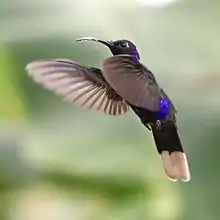 Violettdegenflügel ♂ (Campylopterus hemileucurus)
Violettdegenflügel ♂ (Campylopterus hemileucurus)- Kalkstein-Degenflügel Campylopterus calcirupicola[4]
- Blaukron-Degenflügel (Campylopterus curvipennis)
- Tepuidegenflügel (Campylopterus duidae)
- Weißschwanz-Degenflügel (Campylopterus ensipennis)
- Langschwanz-Degenflügel (Campylopterus excellens)
- Rotschwanz-Degenflügel (Campylopterus falcatus)
- Violettdegenflügel (Campylopterus hemileucurus)
- Rostbauch-Degenflügel (Campylopterus hyperythrus)
- Graubrust-Degenflügel (Campylopterus largipennis)
- Yukatandegenflügel (Campylopterus pampa)
- Santa-Marta-Degenflügel (Campylopterus phainopeplus)
- Buntschwanz-Degenflügel (Campylopterus rufus)
- Napodegenflügel (Campylopterus villaviscensio)
- Gattung Chalybura
- Blauschwanz-Buffonkolibri (Chalybura buffonii)
- Bronzeschwanz-Buffonkolibri (Chalybura urochrysia)
- Gattung Chlorestes
- Blaukinn-Smaragdkolibri (Chlorestes notata)
- Gattung Chlorostilbon
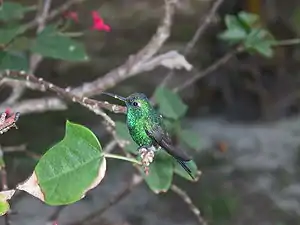 Kubasmaragdkolibri (Chlorostilbon ricordii)
Kubasmaragdkolibri (Chlorostilbon ricordii)- Grünschwanz-Smaragdkolibri (Chlorostilbon alice)
- Gartensmaragdkolibri (Chlorostilbon assimilis)
- Gibsonsmaragdkolibri (Chlorostilbon gibsoni)
- Goldbauch-Smaragdkolibri (Chlorostilbon lucidus)
- Puerto-Rico-Smaragdkolibri (Riccordia maugaeus)
- Westandensmaragdkolibri (Chlorostilbon melanorhynchus)
- Blauschwanz-Smaragdkolibri (Chlorostilbon mellisugus)
- Chiribiquete-Smaragdkolibri (Chlorostilbon olivaresi)
- Kurzschwanz-Smaragdkolibri (Chlorostilbon poortmani)
- Kubasmaragdkolibri (Riccordia ricordii)
- Bronzeschwanz-Smaragdkolibri (Chlorostilbon russatus)
- Schmalschwanz-Smaragdkolibri (Chlorostilbon stenurus)
- Hispaniolasmaragdkolibri (Riccordia swainsonii)
- Gattung Chrysuronia
_Bigger_File.jpg.webp) Bronzeschwanz-Saphirkolibri (Chrysuronia oenone)
Bronzeschwanz-Saphirkolibri (Chrysuronia oenone)- Bronzeschwanz-Saphirkolibri (Chrysuronia oenone)
- Gattung Cyanophaia
- Blaukopfkolibri (Cyanophaia bicolor)
- Gattung Cynanthus
- Goldscheitel-Smaragdkolibri (Cynanthus auriceps)
- Blaugesicht-Breitschnabelkolibri (Cynanthus doubledayi)
- Blaukehl-Breitschnabelkolibri (Cynanthus latirostris)
- Grauer Breitschnabelkolibri (Cynanthus sordidus)
- Gabelschwanz-Smaragdkolibri (Cynanthus canivetii)
- Schwalbenschwanz-Smaragdkolibri (Cynanthus forficatus)
- Gattung Elvira
- Grüner Elvirakolibri (Elvira chionura)
- Bronzekopf-Elvirakolibri (Elvira cupreiceps)
- Gattung Eupherusa
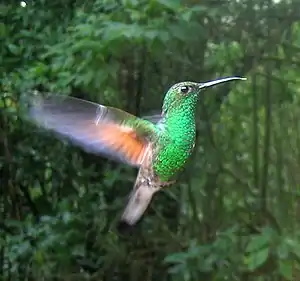 Streifenschwanzkolibri (Eupherusa eximia)
Streifenschwanzkolibri (Eupherusa eximia)- Blauscheitelkolibri (Eupherusa cyanophrys)
- Streifenschwanzkolibri (Eupherusa eximia)
- Schwarzbauchkolibri (Eupherusa nigriventris)
- Weißschwanzkolibri (Eupherusa poliocerca)
- Gattung Eupetomena
- Blauer Gabelschwanzkolibri (Eupetomena macroura)
- Gattung Goethalsia
- Rotgesichtkolibri (Goethalsia bella)
- Gattung Goldmania
- Violettkappenkolibri (Goldmania violiceps)
- Gattung Hylocharis
- Goldsaphirkolibri (Hylocharis chrysura)
- Weißkinn-Saphirkolibri (Hylocharis cyanus)
- Goldschwanz-Saphirkolibri (Hylocharis eliciae)
- Blaukopf-Saphirkolibri (Hylocharis grayi)
- Humboldt-Saphirkolibri (Hylocharis humboldtii)
- Rotkehl-Saphirkolibri (Hylocharis sapphirina)
- Gattung Juliamyia
- Juliakolibri (Juliamyia julie)
- Gattung Klais
_(cropped).jpg.webp) Violettkopfkolibri (Klais guimeti)
Violettkopfkolibri (Klais guimeti)- Violettkopfkolibri (Klais guimeti)
- Gattung Lepidopyga
- Blaukehlkolibri (Lepidopyga coeruleogularis)
- Grünkolibri (Lepidopyga goudoti)
- Blaubauchkolibri (Lepidopyga lilliae)
- Gattung Leucippus
- Baerkolibri (Leucippus baeri)
- Fleckenkolibri (Leucippus chlorocercus)
- Zimtbrustkolibri (Leucippus fallax)
- Taczanowskikolibri (Leucippus taczanowskii)
- Gattung Leucochloris
- Weißkehlkolibri (Leucochloris albicollis)
- Gattung Microchera
- Schneekappenkolibri (Microchera albocoronata)
- Gattung Orthorhyncus
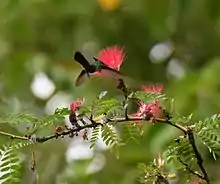 Antillenhaubenkolibri (Orthorhyncus cristatus)
Antillenhaubenkolibri (Orthorhyncus cristatus)- Antillenhaubenkolibri (Orthorhyncus cristatus)
- Gattung Phaeochroa
- Schuppenbrustkolibri (Phaeochroa cuvierii)
- Gattung Stephanoxis
- Spitzhaubenelfe (Stephanoxis lalandi)
- Gattung Taphrospilus
- Tropfenkolibri (Taphrospilus hypostictus),
- Gattung Thalurania
_crop.jpg.webp) Violettkronennymphe (Thalurania colombica) ♀
Violettkronennymphe (Thalurania colombica) ♀- Violettkronennymphe (Thalurania colombica)
- Grünkronennymphe (Thalurania fannyi)
- Schwalbennymphe (Thalurania furcata)
- Blaukronennymphe (Thalurania glaucopis)
- Mexikonymphe (Thalurania ridgwayi)
- Langschwanznymphe (Thalurania watertonii)
- Gattung Trochilus
- Rotschnabel-Jamaikasylphe (Trochilus polytmus)
- Schwarzschnabel-Jamaikasylphe (Trochilus scitulus)
- Gattung Aphantochroa
- Incertae sedis
- Gattung Anthocephala
- Blassstirnkolibri (Anthocephala floriceps)
- Weißfleckenkolibri (Anthocephala berlepschi)
- Gattung Basilinna
- Purpurstirn-Saphirkolibri (Basilinna leucotis)
- Schwarzstirn-Saphirkolibri (Basilinna xantusii)
- Gattung Anthocephala
Literatur
- Jimmy Adair McGuire, Christopher Cooper Witt, James Vanderbeek Remsen Jr, Ammon Corl, Daniel Lee Rabosky, Douglas Leonard Altshuler, Robert Dudley: Molecular phylogenetics and the diversification of hummingbirds. In: Current Biology. Band 24, Nr. 8, 2014, S. 910–916, doi:10.1016/j.cub.2014.03.016.
- Jimmy A. McGuire, Christopher C. Witt, Douglas L. Altshuler, J. V. Remsen Jr (2007): Phylogenetic Systematics and biogeography of hummingbirds: Bayesian and maximum-likelihood analyses of partitioned data and selection of an appropriate partitioning strategy. Syst Biol 56:837–856. doi:10.1080/10635150701656360.
- Jimmy A. McGuire, Christopher C. Witt, J. V. Remsen Jr, R. Dudley, Douglas L. Altshuler (2008): A higher-level taxonomy for hummingbirds. Journal of Ornithology, doi:10.1007/s10336-008-0330-x.
- mit Vítor de Queiroz Piacentini, James Vanderbeek Remsen Jr: A brief history of the generic classification of the Trochilini (Aves: Trochilidae): the chaos of the past and problems to be resolved. In: Zootaxa. Band 4269, Nr. 3, 2017, S. 396–412, doi:10.11646/zootaxa.4269.3.4.
- Frank Garfield Stiles III, James Vanderbeek Remsen Jr, Jimmy Adair McGuire: The generic classification of the Trochilini (Aves: Trochilidae): Reconciling taxonomy with phylogeny. In: Zootaxa. Band 4353, Nr. 3, 2017, S. 401–424, doi:10.11646/zootaxa.4353.3.1.
- Frank Garfield Stiles III, James Vanderbeek Remsen Jr.: The generic nomenclature of the Trochilini: a correction. In: Zootaxa. Band 4691, Nr. 2, 2019, S. 195–196, doi:10.11646/zootaxa.4691.2.10.
- Blanca Estela Hernández-Baños, Luz Estela Zamudio Beltrán, Borja Milá: Phylogenetic relationships and systematics of a subclade of Mesoamerican emerald hummingbirds (Aves: Trochilidae: Trochilini). In: Zootaxa. Band 4784, Nr. 3, 9. März 2020, S. 581–591, doi:10.11646/zootaxa.4748.3.11.
Einzelnachweise
- Trochilidae im Integrated Taxonomic Information System (ITIS). Abgerufen am 21. September 2016.
- McGuire et al. (2007 u. 2008)
- Recognize Colibri cyanotus as a separate species from C . thalassinus. Seite 287 in AOU Classification Committee – North and Middle America - Proposal Set 2016 - C
- Leonardo E. Lopes, Marcelo F. De Vasconcelos and Luiz P. Gonzaga. 2017. A Cryptic New Species of Hummingbird of the Campylopterus largipennis complex (Aves: Trochilidae). Zootaxa. 4268(1); 1–33. doi:10.11646/zootaxa.4268.1.1 PDF